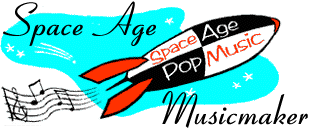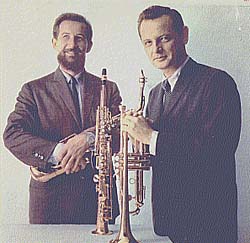Home · Listener's Guide · The Songs · Who's Who · Liner Notes · Selected Tracks · What's New · Search

Les and Larry Elgart
Les ElgartLarry Elgart
- Born 3 August 1918, New Haven, Connecticut
- Died 29 July 1995, Dallas, Texas
- Born 20 March 1922, New London, Connecticut
 Fans of the Elgart brothers probably fall into two camps whose likes and dislikes are exact opposites. Those who like their smooth, steady, tightly-arranged big band music probably hate all the other stuff--experimental, twists, discotheque, and now sounds--they (together and separately) did, and vice versa. Personally, I side with the oddball camp, but I can respect the craftmanship that went into their highly successful "Elgart sound" of the mid-1950s.
Fans of the Elgart brothers probably fall into two camps whose likes and dislikes are exact opposites. Those who like their smooth, steady, tightly-arranged big band music probably hate all the other stuff--experimental, twists, discotheque, and now sounds--they (together and separately) did, and vice versa. Personally, I side with the oddball camp, but I can respect the craftmanship that went into their highly successful "Elgart sound" of the mid-1950s.
Both brothers started as journeymen instrumentalists who spent years playing night after night with some of the best ensembles at the height of the big band era. Surprisingly, although both their parents were accomplished pianists, neither Les nor Larry took an interest in music until their early teens. Music was coded somewhere in their DNA, though, because both were working professionally before the age of 20. Les went on to work with Charlie Spivak, Bunny Berigan, Harry James, and Raymond Scott, and Larry with Spivak, Woody Herman, Red Norvo, Freddie Slack, and Tommy Dorsey. Les never sought out the solo spotlight, but Larry earned a reputation as a master of technique, if not innovation, on the alto sax.
Occasionally the brothers found themselves playing in the same bands, and soon after the end of World War Two, they decided to get together and form their own group. From their years as sidemen, they'd come to know the work of a great many arrangers, and they hired some of the best then writing--including Nelson Riddle, Bill Finegan, and Ralph Flanagan--to build their book. Unfortunately, they soon learned that timing is everything: the Musicians' Union record ban, vets settling down to start on the Baby Boom, and the downsizing of venues and earnings for live performers left them deeply in debt within a few years, and they ended up disbanding and selling their arrangements to Tommy Dorsey.
For the next few years, Les and Larry went their separate ways, slogging through countless road bands and pit orchestras. While playing with one Broadway show band, Larry met the young Charles Albertine, who was playing sax but already dabbling with composition and arrangements. Inspired by his work, Larry approached Brunswick Records and convinced them to contract for two 10-inch albums featuring Albertine's original compositions: Impressions of Outer Space and Music for Barefoot Ballerinas. A few lucky hi-fi buffs who bought these records recognized the ambitious and modernistic ideas Albertine and Elgart were experimenting with, similar in some ways to Stan Kenton's championing of Bob Graettinger's "City of Glass," but the records were not particularly successful.
The experience gave Larry a chance to learn about the changes in recording technology and techniques that had taken place since his own band was working. With these in mind, Larry and Albertine took a different approach to constructing a big band and arrived at what became known as the "Elgart sound." More sensitive mikes and other features greatly improved the subtlety of sounds that could be brought out, and also reduced the need for a heavy rhythm section. Exploiting these features, they arrived at a group centered around two tightly-synchronized sax and brass sections, cut the piano from the rhythm section, and eliminated almost all solo turns.
This time, timing was on their side. Their more understated harmonies and lighter but consistent beat was a big hit with listeners and dancers. Beginning with Sophisticated Swing in 1953, they had a steady string of albums placed in the Top 20, competing with the likes of Sinatra and genuine and ersatz early rock-and-roll. One of their upbeat numbers, an Albertine original titled "Bandstand Boogie" was adopted by the then-truly young Dick Clark for his new show, "American Bandstand."
Throughout the band's golden years, Les was more interested in the business than the music. Although their album covers show Les holding a trumpet, he was never more than a passable player and stopped performing live or on recordings sometime during the late 1950s. He eventually decided to retire from performing in 1959. Larry formed his own band and went to RCA (and later, MGM), sticking with pretty much the same formula. By now, though, the novelty had become passe, and the "Elgart sound" was falling by the wayside, dismissed as "Businessmen's Bounce." Larry started out with what RCA proclaimed as New Sounds at the Roosevelt [Hotel],including arrangements by Al Cohn, but just three years later, he was catering to the "stereo action" craze as part of MGM's "21 Channel Sound" series of "Music in Motion."
In 1963, Larry gave brotherhood a third chance, reuniting with Les and pulling Charles Albertine away from his work with Sammy Kaye and others. As ten years before, they found that success often comes from learning to switch instead of fight, and they were soon covering contemporary material, reaching out to the kids who wanted to be "Going to a Go-Go" instead of waltzing once again around the old dance floor. Albertine left to work in Hollywood, and Larry enlisted the multi-talented Bobby Scott to replace him as lead arranger. Scott brought blend of jazz and rock sensibilities, and helped the Elgarts create a series of very enjoyable "now sound" albums for Columbia and MGM.
Les bowed out once again and moved to Texas. He performed occasionally, hiring pick-up musicians since the fading demand wouldn't support a steady ensemble. Larry apparently never shed a tear at their parting: "I never agreed with him musically. He was more trouble than anything else," he commented to an interviewer recently. He kept on trying to keep a band going, taking whatever work could be had. He lucked into a lucrative sales streak in the early 1980s, when his New Manhattan Swing Band rode perhaps the last big wave to roll onto middle American turntables: Hooked-On Swing. Larry pumped out a steady 2-3 big band hits per minute without missing a beat, offering Mom and Pop a taste of what the Germans had known for years as "non-stop dancing" from the likes of James Last, and sold a ton of records. Larry has said that one of the reasons "Hooked On Swing" is so popular is its "happy sound. Many people tell me that they listen to it while running, walking, or doing water aerobics."
"Hooked on Swing" went the way of all vinyl by the late 1980s, though, but Larry Elgart continues to work the circuit--wherever it may lead, to cruise ship, casino, or mature living community--till today. His most recent CD, Live at the Ambassador, features the same predictable middlebrow swing that's been his gravy train for the last four decades. You can find out more about his latest enterprise at http://www.producersinc.com/artists/larryelgart/artist_elgart.html. If you're a member of the "oddball Elgart" camp, though, you're better off surfing to the nearest thrift store for that "now sounds" gem, Girl Watchers.
Recordings
Les & Larry Elgart Albums- Impressions of Outer Space, Brunswick BL58054 (1953)
- Prom Date, Columbia CL2503 (1954)
- Campus Hop, Columbia CL2578 (1954)
- More of Les, Columbia CL2590 (1955)Sophisticated Swing, Columbia CL-536, 33 LP, (1953)
- Just One More Dance, Columbia CL-594, (1954)
- The Band of the Year, Columbia CL-619, (1954)
- The Dancing Sound, Columbia CL-684, (1954)
- For Dancers Only, Columbia CL-803, (1955)
- The Elgart Touch, Columbia CL-875, (1955)
- The Most Happy Fella Columbia CL-904, (1956)
- For Dancers Also, Columbia CL-1008 (1956)
- Sound Ideas, Columbia CL-1123/CS8002 (1958)
- Les & Larry Elgart & Their Orchestra, Columbia CL1052/CS8092 (1958)
- Les Elgart On Tour, Columbia CL1291/CS8103 (1959)
- The Great Sound of Les Elgart, Columbia CL1350/CS8159 (1959)
- The Band With That Sound , Columbia1 CL450/CS9245 (1960)
- Designs For Dancing, Columbia1 CL500/CS8291(1960)
- Half Satin Half Latin, Columbia CL1567/CS8367 (1960)
- It's De-Lovely, Columbia1 CL659/CS8459, (1961)
- The Twist Goes To College, Columbia CL1785/CS8565, (1962)
- Best Band On Campus, Columbia CL1890/CS8690, (1962)
- Big Band Hootenany, Columbia CL2112/CS8912, (1963)
- Command Performance, Columbia CL2221/CS9021, (1964)
- The New Elgart Touch, Columbia CL2301/CS9101, (1965)
- Elgart au Go-Go, Columbia CL2355/CS9155, (1965)
- Sound of the Times, Columbia CL2511/CS9311, (1966)
- Warm and Sensuous, Columbia CL2591/CS9391 (1966)
- Girl Watchers, Columbia CL2633/CS9433, (1967)
- Wonderful World of Today's Hits, Columbia CL2780/CS9580 (1967)
- Ain't We Got Fun, DRIVE Archive DES2-41068 CD (1995)
- Band With Strings, Decca DL-5526, (1954) (very rare)
- Larry Elgart & His Orchestra, Decca DL-8034 (1954)
- Barefoot Ballerina, Decca DL8034 (1955)
- Lary Elgart and His Orchestra, RCA Victor LPM/LSP-1961 (1959)
- New Sounds at The Roosevelt, RCA Victor LPM/LSP-2045 (1959)
- Saratoga, RCA Victor Victor LPM/LSP-2166 (1960)
- Easy Goin' Swing, RCA-Camden CAS-575 (1960)
- Sophisticarted Sixties, MGM E/SE3891 (1960)
- The Shape of Sounds To Come, MGM E/SE3896 (1961)
- Visions, MGM E/SE3961 (1961)
- The City, MGM E/SE4007 (1961)
- Music in Motion!, MGM E/SE4028, (1962)
- More Music in Motion, MGM E/SE4080, (1962)
- The Larry Elgart Dance Band, Project 3 PR 5102 (1979) (reissue of "New Sounds at the Roosevelt")
- Flight of the Condor, RCA Victor AFL1-4095, (1981)
- Hooked on Swing, RCA Victor AFL1-4343, (1982)
- Hooked on Swing 2, AYL5026, (1983)
- Larry Elgart and His Swing Orchestra, RCA Victor AFL1-4850, (1983)
- Live at the Ambassador, Quick Silver (1995)
- Let My People Swing, K-Tel 3459 (also a reissue of "New Sounds at the Roosevelt")
S p a c e A g e P o p M u s i c
Home · Listener's Guide · The Songs · Who's Who · Liner Notes · Selected Tracks · What's New · Search
Email: editor@spaceagepop.com